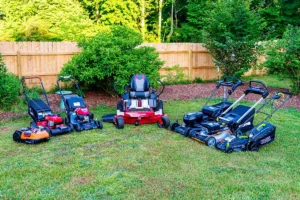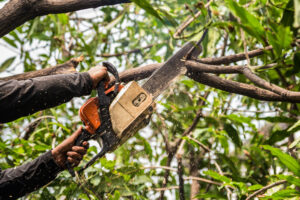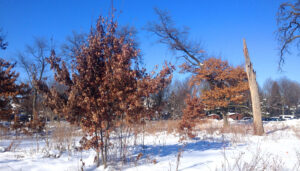Comprehensive Guide to Tree Removal Equipment: Tools, Tips, and Where to Buy
Tree removal is a complex task that requires the right tools and expertise to be performed safely and efficiently. Whether you’re a professional arborist or a homeowner dealing with a large tree on your property, understanding the various equipment options available and how to use them is crucial. This guide will cover the essential tree removal equipment, the best places to buy them, and key considerations when choosing the right tools for your job.
1. Chainsaws
Overview: Chainsaws are the backbone of tree removal equipment. They are powerful tools designed to cut through large tree trunks and branches with ease. Chainsaws come in various sizes, ranging from lightweight models for small branches to heavy-duty versions suitable for felling large trees.
Types of Chainsaws:
- Gas-Powered Chainsaws: These are the most powerful chainsaws, ideal for heavy-duty tree removal. They are cordless and can handle thick trunks and large branches but require more maintenance and produce exhaust fumes.
- Electric Chainsaws: These are quieter and easier to maintain than gas-powered ones. They are suitable for smaller tasks and are available in corded and cordless (battery-powered) versions.
- Battery-Powered Chainsaws: These offer the convenience of cordless operation with less noise and fumes. However, their battery life can limit the duration of heavy-duty tasks.
Top Brands:
- Stihl: Known for its durability and power, Stihl chainsaws are popular among professionals.
- Husqvarna: Offers a range of powerful chainsaws with advanced features like automatic chain lubrication and anti-vibration technology.
- EGO: Specializes in battery-powered chainsaws that are lightweight and easy to use.
Where to Buy: Chainsaws are available at major hardware stores like Home Depot, Lowe’s, and specialized equipment retailers such as Northern Tool and Equipment. Online platforms like Amazon also offer a wide selection with user reviews that can help guide your purchase.
Safety Tips:
- Always wear protective gear, including chainsaw chaps, gloves, a helmet, and eye and ear protection.
- Check the chain tension regularly and keep the chain sharp to prevent kickbacks.
- Start the saw on the ground or a stable surface and maintain a firm grip when operating.
2. Pole Saws
Overview: Pole saws are essentially chainsaws on an extension pole, designed for pruning high branches without the need for a ladder. They are ideal for trimming branches that are difficult to reach, making them a valuable tool for tree maintenance.
Types of Pole Saws:
- Manual Pole Saws: These are non-motorized and rely on your strength to saw through branches. They are lightweight and ideal for smaller branches.
- Electric Pole Saws: These can be corded or battery-powered. They are easy to use and quieter than gas models, making them suitable for residential areas.
- Gas-Powered Pole Saws: These provide the most power and are best for larger branches and tougher tasks.
Top Brands:
- Greenworks: Known for its battery-powered models that are lightweight and environmentally friendly.
- Remington: Offers both electric and gas-powered options, known for their reliability and ease of use.
- Sun Joe: Specializes in electric pole saws that are affordable and user-friendly for home use.
Where to Buy: Pole saws can be purchased from Home Depot, Lowe’s, Ace Hardware, and online platforms such as Amazon and Walmart.
Safety Tips:
- Inspect the area for power lines and ensure there is adequate clearance.
- Position yourself safely, never directly under the branch you’re cutting.
- Use both hands to maintain control and balance.
3. Tree Pruners
Overview: Tree pruners are essential for detailed tree care, allowing you to trim smaller branches and twigs to shape the tree or remove dead wood. Pruners are usually long-handled tools that provide leverage, making it easier to cut branches cleanly.
Types of Tree Pruners:
- Bypass Pruners: These have a scissor-like action, ideal for live branches as they provide a clean cut that doesn’t crush the branch.
- Anvil Pruners: These have a single sharp blade that cuts against a flat surface (anvil). They are best for dead or dry branches.
- Ratchet Pruners: These feature a ratcheting mechanism that allows you to cut through thicker branches with less effort.
Top Brands:
- Fiskars: Known for ergonomic designs and durable blades.
- Corona: Offers a variety of pruners with features like extendable handles and comfortable grips.
- Felco: Swiss-made pruners favored by professionals for their precision and longevity.
Where to Buy: Tree pruners are available at garden centers, hardware stores like Home Depot and Lowe’s, and online at Amazon and Walmart.
Safety Tips:
- Use pruners for their intended purpose; avoid cutting branches that are too thick.
- Wear gloves to protect your hands from blisters and cuts.
- Keep the blades sharp to ensure clean cuts and reduce the risk of damaging the tree.
4. Wood Chippers
Overview: After cutting down a tree, wood chippers help dispose of the branches and small trunks by chipping them into mulch or smaller pieces. This not only makes disposal easier but also allows you to recycle the wood as mulch for landscaping.
Types of Wood Chippers:
- Electric Chippers: Suitable for smaller jobs, these are quieter and more environmentally friendly but have less power than gas models.
- Gas-Powered Chippers: These are more powerful and can handle larger branches. They are the preferred choice for bigger jobs or regular use.
- Commercial Chippers: Used by professionals, these large machines can handle very large branches and trunks and are usually towed behind a truck.
Top Brands:
- Troy-Bilt: Offers a range of gas-powered chippers known for their durability and power.
- Patriot Products: Known for producing high-quality electric chippers that are powerful enough for most residential needs.
- DR Power: Specializes in heavy-duty chippers designed for large properties and professional use.
Where to Buy: You can buy wood chippers at stores like Home Depot, Lowe’s, Northern Tool, and specialized outdoor equipment retailers.
Safety Tips:
- Always read the manufacturer’s instructions and warnings.
- Wear eye protection, gloves, and hearing protection when operating a chipper.
- Keep your hands and other body parts away from the feeding mechanism and never attempt to unclog the chipper while it’s running.
5. Stump Grinders
Overview: Stump grinders are used to remove the remaining stump after a tree has been cut down. This is essential for preventing regrowth and preparing the ground for landscaping or construction. Stump grinders use a rotating cutting disc to grind the stump into wood chips.
Types of Stump Grinders:
- Handheld Stump Grinders: These are portable and suitable for small stumps. They are ideal for homeowners dealing with occasional stump removal.
- Walk-Behind Stump Grinders: These are more powerful than handheld versions and can handle larger stumps. They are easy to maneuver around the yard.
- Towable Stump Grinders: Used by professionals, these machines are large, powerful, and can be towed behind a truck. They are ideal for large stumps and commercial applications.
Top Brands:
- Vermeer: A leading brand in stump grinders, offering powerful models for both residential and commercial use.
- Husqvarna: Known for their robust and easy-to-use grinders with advanced features.
- DR Stump Grinders: Popular among homeowners for their efficiency and ease of use.
Where to Buy: Stump grinders can be purchased at Home Depot, Northern Tool, and specialized landscape equipment suppliers.
Safety Tips:
- Ensure you know how to operate the machine safely; read the manual thoroughly.
- Wear protective gear, including safety glasses, gloves, and ear protection.
- Keep children and pets away from the work area.
6. Safety Gear
Overview: Safety gear is non-negotiable when it comes to tree removal. Even experienced professionals must wear the appropriate safety equipment to protect themselves from potential hazards like falling branches, chainsaw kickback, and flying debris.
Essential Safety Gear:
- Helmets: Protect your head from falling branches and other impacts.
- Safety Glasses: Shield your eyes from dust, debris, and sawdust.
- Ear Protection: Chainsaws and other equipment can be loud; earplugs or earmuffs protect your hearing.
- Gloves: Provide grip and protect your hands from cuts, blisters, and vibrations.
- Chainsaw Chaps: Protect your legs from chainsaw contact, reducing the severity of potential injuries.
Top Brands:
- Stihl: Offers a full range of safety gear designed specifically for tree work.
- Husqvarna: Known for durable and comfortable safety equipment.
- 3M: Specializes in hearing and eye protection gear.
Where to Buy: Safety gear is available at most hardware stores, as well as online on Amazon, Home Depot, and specialized safety
equipment retailers.
Safety Tips:
- Always wear the full set of safety gear; never skip on protection.
- Regularly inspect your safety gear for wear and tear and replace any damaged items.
7. Ropes and Rigging Equipment
Overview: Ropes and rigging equipment are essential for safely lowering cut branches and tree sections, especially when working at heights or in confined spaces. Proper rigging ensures that branches fall in a controlled manner, reducing the risk of injury or property damage.
Types of Rigging Equipment:
- Climbing Ropes: Used by arborists to climb trees safely. They are strong, lightweight, and designed to hold the weight of a person.
- Rigging Ropes: Used for lowering branches. These ropes are strong and durable, capable of handling heavy loads.
- Harnesses: Essential for safely climbing trees and performing aerial work.
- Pulleys and Carabiners: Used to redirect ropes and secure equipment.
Top Brands:
- Petzl: Known for high-quality climbing gear, including harnesses and helmets.
- Notch Equipment: Specializes in arborist equipment, including ropes and rigging gear.
- Buckingham: Offers a wide range of climbing and safety equipment for tree work.
Where to Buy: Ropes and rigging equipment can be found at specialized arborist supply stores, REI, and online retailers.
Safety Tips:
- Ensure all rigging equipment is rated for the load you intend to carry.
- Inspect ropes and harnesses regularly for signs of wear or damage.
- Always follow proper rigging techniques and never exceed the weight limits of your equipment.
Conclusion
Tree removal is a task that requires careful planning, the right equipment, and strict adherence to safety protocols. By investing in quality tools like chainsaws, pole saws, pruners, wood chippers, stump grinders, and safety gear, you can tackle tree removal efficiently and safely. Always choose equipment that matches the size and scope of your project, and don’t hesitate to seek professional help for larger or more dangerous jobs. Remember, safety is paramount, so equip yourself properly and take the necessary precautions to protect yourself and others around you.
This comprehensive guide provides a solid foundation for understanding the essential equipment needed for tree removal, where to purchase these tools, and best practices for their use. With the right equipment and knowledge, you can confidently manage your tree removal tasks and maintain a safe and tidy landscape.
Would you like images for the equipment mentioned, or further details on specific models and prices?




